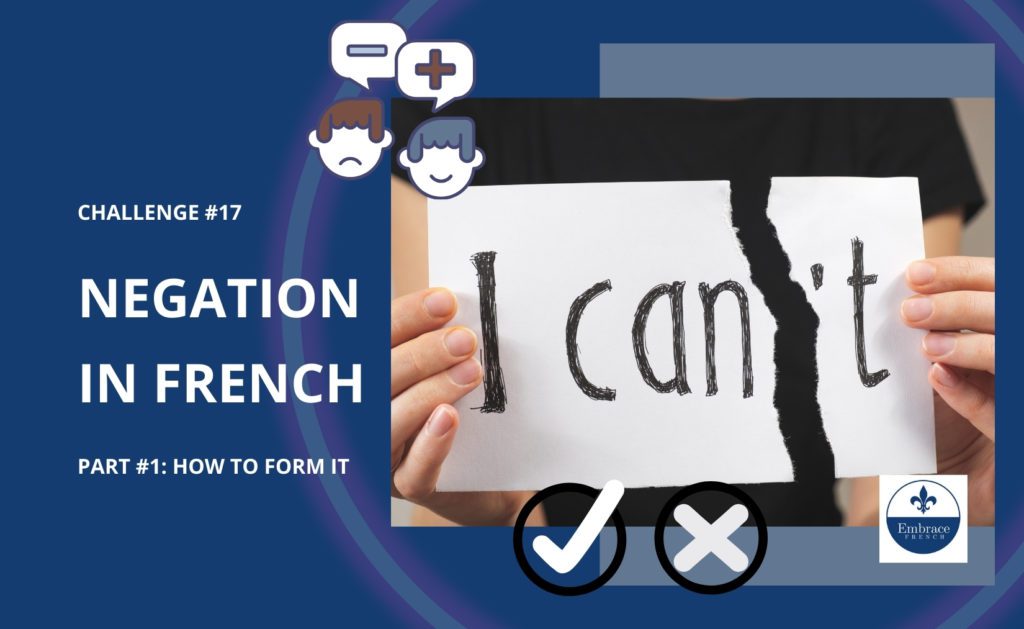Negation in French
Part #1: How to form it
CHALLENGE #17

As in all languages, negation is used in French to express the opposite of a positive statement.
The difference probably lies in the fact that in French, not only does it take two words to create the negation, but there are several ways of forming it, depending on context and sentence structure.
So I have decided to divide this article into two parts. Today, we’ll look at how to form negation and in the next article, we’ll look at the different forms of negation.
Rest assured, nothing will be complicated, and I’m going to use this article to make negation child’s play for you!
N’ = Ne
Before we start, it’s worth mentioning that the n with an apostrophe (n’) is simply the « ne » in front of a word beginning with a vowel. It’s the same principle as « le » or « la », which sometimes become L with an apostrophe. For example, we don’t say « la école », but « l’école ».
How to form negation
In French, we use two words to form negation: “ne” and “pas”. To form it, wedge the verb between “ne” and “pas”.
Here are the steps to change from an affirmative to a negative sentence:
- Identify the verbe
- Place “ne” in front of the verb.
- Place “pas” after the verb.
Here are some examples:
- Il aime les films d’horreur. → Il n’aime pas les films d’horreur.
- Nous allons à la piscine aujourd’hui. → Nous n’allons pas à la piscine aujourd’hui.
- Mon frère aime se lever tôt. → Mon frère n’aime pas se lever tôt.
- Tu comprends cette question. → Tu ne comprends pas cette question.
As you can see, it’s quite simple to turn an affirmative sentence into a negative one. But for the sake of this post, allow me a few more minutes to show you some of the particularities of negation in French.
Imperative: or when there is no pronoun
The imperative verb tense is used to give an order, a forbidding statement, a recommendation or an advice. As mentioned in this other post, it is conjugated only with « tu », « nous » and « vous », and the pronoun is never mentioned.
When a sentence with an imperative verb is negative, the « ne…pas » is placed according to the same rule. It’s just that, given the absence of the pronoun, the « ne » usually starts the sentence.
Here are a few examples:
- Ne parle pas si fort. (Don’t talk so loud.)
- Ne mange pas ce gâteau. (Don’t eat this cake.)
- Ne faisons pas de bruit. (Don’t make any noise.)
When there are two verbs
Here, I’m talking about two situations:
In the passé composé: when an auxiliary (être or avoir) + a past participle is used, as in « Je suis allé chez ma grand-mère ».
When an infinitive verb is placed immediately after a conjugated verb, as in « Je peux parler français ».
In both cases, the negation is formed in the same way, i.e. the « ne » is in front of the verb, except that the « pas » is placed between the two verbs.
With passé composé:
- Il n’a pas compris la leçon. (He didn’t understand the lesson.)
- Elle n’est pas venue à la réunion. (She didn’t come to the meeting.)
- Nous n’avons pas visité ce musée. (We didn’t visit that museum.)
With an infinitive verb after a conjugated verb:
- Il ne veut pas partir. (He doesn’t want to leave.)
- On ne choisit pas sa famille. (You can’t choose your family.)
- Nous ne souhaitons pas discuter de ce sujet délicat. (We do not wish to discuss this delicate subject.)
When you don’t need the “ne”
When two elements are placed in opposition, one positive and one negative, the « ne » is not used and only the « pas » is placed in front of the second element.
Here are some examples:
- Il aime les fruits, mais pas le chocolat. (He likes fruits, but not chocolate.)
- Elle adore voyager, mais pas les longs trajets en avion. (She loves to travel, but not long plane journeys.)
- Nous avons récolté beaucoup de légumes, mais pas de fruits. (We have harvested lots of vegetables, but no fruits.)
Why does the “ne” disappear when people speak?
If you regularly hear people speak in French, you may have noticed that they say « Je veux pas partir » instead of « Je ne veux pas partir ».
You know, in English, people rarely say « do not », opting instead for « don’t ». It’s much the same in French, except that these little « shortcuts » are not allowed in writing.
Your challenge: turn these affirmative sentences into negative ones
For your challenge, I’m going to give you affirmative sentences to turn into negative ones. They include everything we have just seen: the regular rule, the imperative, when there are two verbs, and negation with the « pas » without the « ne ».
As usual, the answers to this challenge can be found on our Facebook page.
Here are 10 affirmative sentences. Turn them into negative sentences.
To help you, I have put the negative sentences in English in brackets for cases of opposition between two elements.
- Tu vois la scène.
- Ils ont fini leur projet.
- Laisse la porte ouverte.
- Je parle couramment l’anglais et l’espagnol. (I am fluent in English, but not in Spanish.)
- Je dois rembourser le gouvernement.
- Tu as répondu à l’invitation.
- Nous parlons français.
- Tu as réussi le premier test et le deuxième. (You passed the first test, but not the second.)
- Soyez en retard.
- Il veut accepter l’offre d’emploi.
Have you downloaded your free guidebook package?

You can now download a free learning package on the 20 most commonly used verbs in French, conjugated in the present tense. This set includes an ebook with all the verbs and a sentence for each person (je, tu, il, elle, nous, vous, ils, elles), an Excel file to add all the concepts from the ebook to your flashcards application and a video where you can hear me pronounce these verbs and sentences. And it’s free! Download it now!


